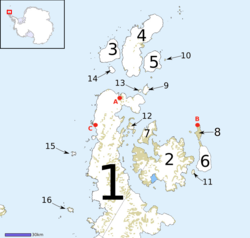Graham Land: Difference between revisions
Created page with 'right|thumb|250px|Northern Graham Land and the surrounding islands.<br>'''1''' [[Antarctic Peninsula, '''2''' [[James Ross …' |
mNo edit summary |
||
| (One intermediate revision by one other user not shown) | |||
| Line 1: | Line 1: | ||
[[File:Penguin porpoising in Paradise Harbour, Antarctica (6087862348).jpg|right|thumb|350px|Paradise Harbour, Graham Land]] | |||
'''Graham Land''' is a part of the [[British Antarctic Territory]] comprising the northern portion of the [[Antarctic Peninsula]]; the parts north of a line joining [[Cape Jeremy]] and [[Cape Agassiz]]. | |||
[[File:Wfm antarctic peninsula islands.png|right|thumb|250px|Northern Graham Land and the surrounding islands.<br>'''1''' [[Antarctic Peninsula]], '''2''' [[James Ross Island]], '''3''' [[D'Urville Island]], '''4''' [[Joinville Island]], '''5''' [[Dundee Island]], '''6''' [[Snow Hill Island]], '''7''' [[Vega Island]], '''8''' [[Seymour Island]], '''9''' [[Andersson Island]], '''10''' [[Paulet Island]], '''11''' [[Lockyer Island]], '''12''' [[Eagle Island, Antarctica|Eagle Island]], '''13''' [[Jonassen Island]], '''14''' [[Bransfield Island]], '''15''' [[Astrolabe Island]], '''16''' [[Tower Island]]]] | [[File:Wfm antarctic peninsula islands.png|right|thumb|250px|Northern Graham Land and the surrounding islands.<br>'''1''' [[Antarctic Peninsula]], '''2''' [[James Ross Island]], '''3''' [[D'Urville Island]], '''4''' [[Joinville Island]], '''5''' [[Dundee Island]], '''6''' [[Snow Hill Island]], '''7''' [[Vega Island]], '''8''' [[Seymour Island]], '''9''' [[Andersson Island]], '''10''' [[Paulet Island]], '''11''' [[Lockyer Island]], '''12''' [[Eagle Island, Antarctica|Eagle Island]], '''13''' [[Jonassen Island]], '''14''' [[Bransfield Island]], '''15''' [[Astrolabe Island]], '''16''' [[Tower Island]]]] | ||
[[File:Falkland Islands Dependencies 1944 9d Graham Land.jpg|right|thumb|150px|Falkland Islands stamp of 1944 overprinted for use in Graham Land]] | [[File:Falkland Islands Dependencies 1944 9d Graham Land.jpg|right|thumb|150px|Falkland Islands stamp of 1944 overprinted for use in Graham Land]] | ||
Graham Land is the closest part of Antarctica to South America<ref>[http://sci.esa.int/science-e/www/object/index.cfm?fobjectid=41768 ESA Science & Technology: Graham Land]</ref> and the only part of the continent of Antarctica to project north of the Antarctic Circle. | Graham Land is the closest part of Antarctica to South America<ref>[http://sci.esa.int/science-e/www/object/index.cfm?fobjectid=41768 ESA Science & Technology: Graham Land]</ref> and the only part of the continent of Antarctica to project north of the Antarctic Circle. | ||
Latest revision as of 10:12, 7 January 2021

Graham Land is a part of the British Antarctic Territory comprising the northern portion of the Antarctic Peninsula; the parts north of a line joining Cape Jeremy and Cape Agassiz.

1 Antarctic Peninsula, 2 James Ross Island, 3 D'Urville Island, 4 Joinville Island, 5 Dundee Island, 6 Snow Hill Island, 7 Vega Island, 8 Seymour Island, 9 Andersson Island, 10 Paulet Island, 11 Lockyer Island, 12 Eagle Island, 13 Jonassen Island, 14 Bransfield Island, 15 Astrolabe Island, 16 Tower Island

Graham Land is the closest part of Antarctica to South America[1] and the only part of the continent of Antarctica to project north of the Antarctic Circle.
Name
Formerly the name "Graham Land" was that of the whole peninsula, but while Britain gave it that name, the Americans applied the name "Palmer Land" to the peninsula after an American sea captain. To avoid confusion and argument, in 1964 agreement was reached between the British Antarctic Place-names Committee and the American Advisory Committee on Antarctic Names, that the name "Antarctic Peninsula" be approved for the major peninsula of Antarctica, and the names "Graham Land" and "Palmer Land" for its northern and southern portions, respectively. Both Graham Land and Palmer Land are within the British Antarctic Territory
Graham Land is named after Sir James R G Graham, First Lord of the Admiralty at the time of John Biscoe's exploration of the west side of Graham Land in 1832.
British Graham Land Expedition
The British Graham Land Expedition was an expedition to Graham Land between 1934 and 1937, for the purpose of geophysical survey and exploration. It followed on the work of any earlier British expedition to Graham Land led by John Lachlan Cope between 1920 and 1922.
Under the leadership of John Riddoch Rymill, the expedition spent two years in the Antarctic. The expedition determined that Graham Land was a peninsula.[2] The expedition used a combination of traditional and modern practices in Antarctic exploration, using both dog teams and motor sledges as well as a single-engine de Havilland Fox Moth aircraft for exploration. The voyage to the Antarctic was in an elderly three-masted sailing ship christened the Penola, which had an unreliable auxiliary engine.[2] Additional supplies were brought on the ship Discovery II.
The expedition was one of the last privately-sponsored Antarctic missions, of which only part of the cost covered by the British government. Although the expedition had a very small budget, it was successful in its scientific objectives. Air survey photography and mapping was carried out for 1000 miles of the Graham Land coast.
All sixteen members of the landing party received the Polar Medal. One of the participants of the BGLE was Dr Brian Birley Roberts, who later contributed to the drafting of the Antarctic Treaty.[3]
Outside links
| ("Wikimedia Commons" has material about Graham Land) |
References
- ↑ ESA Science & Technology: Graham Land
- ↑ 2.0 2.1 David McGonigal Antarctica: Secrets of the Southern Continent, Frances Lincoln Ltd, 2009. ISBN 0-7112-2980-5, page 334-33
- ↑ Gordon Elliott Fogg A history of Antarctic science Cambridge University Press, 1992 ISBN 0-521-36113-3 pp.178-179
- Description of the British Graham Land Expedition from the Scott Polar Research Institute
- British Graham Land Expedition
- British Graham Land Expedition 2007
- Detailed description of the expedition
- British Graham Land Expedition in Bernard Stonehouse (ed) Encyclopedia of Antarctica and the southern oceans John Wiley and Sons, 2002 ISBN 0-471-98665-8
- British Graham Land Expedition in Beau Riffenburgh (ed), Encyclopedia of the Antarctic, Volume 1, CRC Press, 2007 ISBN 0-415-97024-5,
